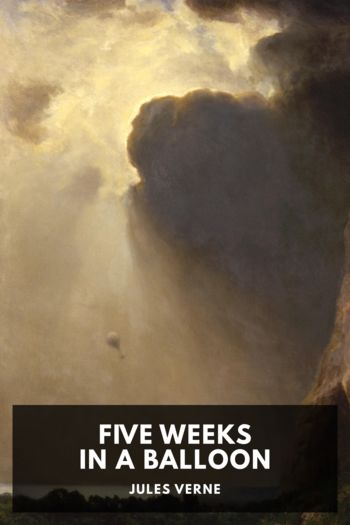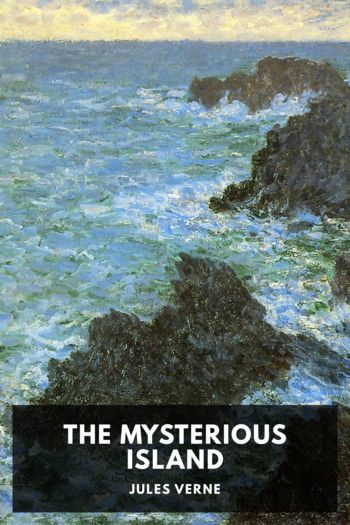Five Weeks in a Balloon, Jules Verne [best interesting books to read TXT] 📗

- Author: Jules Verne
Book online «Five Weeks in a Balloon, Jules Verne [best interesting books to read TXT] 📗». Author Jules Verne
The country in the elbow of the Niger—A fantastic view of the Hombori mountains—Kabra—Timbuktu—The Chart of Dr. Barth—A decaying city—Whither heaven wills.
During this dull Monday, Dr. Ferguson diverted his thoughts by giving his companions a thousand details concerning the country they were crossing. The surface, which was quite flat, offered no impediment to their progress. The doctor’s sole anxiety arose from the obstinate northeast wind which continued to blow furiously, and bore them away from the latitude of Timbuktu.
The Niger, after running northward as far as that city, sweeps around, like an immense water-jet from some fountain, and falls into the Atlantic in a broad sheaf. In the elbow thus formed the country is of varied character, sometimes luxuriantly fertile, and sometimes extremely bare; fields of maize succeeded by wide spaces covered with broomcorn and uncultivated plains. All kinds of aquatic birds—pelicans, wild-duck, kingfishers, and the rest—were seen in numerous flocks hovering about the borders of the pools and torrents.
From time to time there appeared an encampment of Touaregs, the men sheltered under their leather tents, while their women were busied with the domestic toil outside, milking their camels and smoking their huge-bowled pipes.
By eight o’clock in the evening the Victoria had advanced more than two hundred miles to the westward, and our aeronauts became the spectators of a magnificent scene.
A mass of moonbeams forcing their way through an opening in the clouds, and gliding between the long lines of falling rain, descended in a golden shower on the ridges of the Hombori Mountains. Nothing could be more weird than the appearance of these seemingly basaltic summits; they stood out in fantastic profile against the sombre sky, and the beholder might have fancied them to be the legendary ruins of some vast city of the middle ages, such as the icebergs of the polar seas sometimes mimic them in nights of gloom.
“An admirable landscape for the ‘Mysteries of Udolpho’!” exclaimed the doctor. “Ann Radcliffe could not have depicted yon mountains in a more appalling aspect.”
“Faith!” said Joe, “I wouldn’t like to be strolling alone in the evening through this country of ghosts. Do you see now, master, if it wasn’t so heavy, I’d like to carry that whole landscape home to Scotland! It would do for the borders of Loch Lomond, and tourists would rush there in crowds.”
“Our balloon is hardly large enough to admit of that little experiment—but I think our direction is changing. Bravo!—the elves and fairies of the place are quite obliging. See, they’ve sent us a nice little southeast breeze, that will put us on the right track again.”
In fact, the Victoria was resuming a more northerly route, and on the morning of the 20th she was passing over an inextricable network of channels, torrents, and streams, in fine, the whole complicated tangle of the Niger’s tributaries. Many of these channels, covered with a thick growth of herbage, resembled luxuriant meadow-lands. There the doctor recognized the route followed by the explorer Barth when he launched upon the river to descend to Timbuktu. Eight hundred fathoms broad at this point, the Niger flowed between banks richly grown with cruciferous plants and tamarind-trees. Herds of agile gazelles were seen skipping about, their curling horns mingling with the tall herbage, within which the alligator, half concealed, lay silently in wait for them with watchful eyes.
Long files of camels and asses laden with merchandise from Jenné were winding in under the noble trees. Ere long, an amphitheatre of low-built houses was discovered at a turn of the river, their roofs and terraces heaped up with hay and straw gathered from the neighboring districts.
“There’s Kabra!” exclaimed the doctor, joyously; “there is the harbor of Timbuktu, and the city is not five miles from here!”
“Then, sir, you are satisfied?” half queried Joe.
“Delighted, my boy!”
“Very good; then everything’s for the best!”
In fact, about two o’clock, the Queen of the Desert, mysterious Timbuktu, which once, like Athens and Rome, had her schools of learned men, and her professorships of philosophy, stretched away before the gaze of our travellers.
Ferguson followed the most minute details upon the chart traced by Barth himself, and was enabled to recognize its perfect accuracy.
The city forms an immense triangle marked out upon a vast plain of white sand, its acute angle directed toward the north and piercing a corner of the desert. In the environs there was almost nothing, hardly even a few grasses, with some dwarf mimosas and stunted bushes.
As for the appearance of Timbuktu, the reader has but to imagine a collection of billiard-balls and thimbles—such is the bird’s-eye view! The streets, which are quite narrow, are lined with houses only one story in height, built of bricks dried in the sun, and huts of straw and reeds, the former square, the latter conical. Upon the terraces were seen some of the male inhabitants, carelessly lounging at full length in flowing apparel of bright colors, and lance or musket in hand; but no women were visible at that hour of the day.
“Yet they are said to be handsome,” remarked the doctor. “You see the three towers of the three mosques that are the only ones left standing of a great number—the city has indeed fallen from its ancient splendor! At the top of the triangle rises the Mosque of Sankore, with its ranges of galleries resting on arcades of sufficiently pure design. Farther on, and near to the Sane-Gungu quarter, is the Mosque of Sidi-Yahia and some two-story houses. But do not look for either palaces or monuments: the sheik is a mere son of traffic, and his royal palace is a countinghouse.”
“It seems to me that I can see half-ruined ramparts,” said Kennedy.
“They were destroyed by the Fouillanes in 1826; the city was one-third larger then, for Timbuktu, an object generally coveted by all the tribes, since the eleventh century, has belonged in succession to the Touaregs, the





Comments (0)